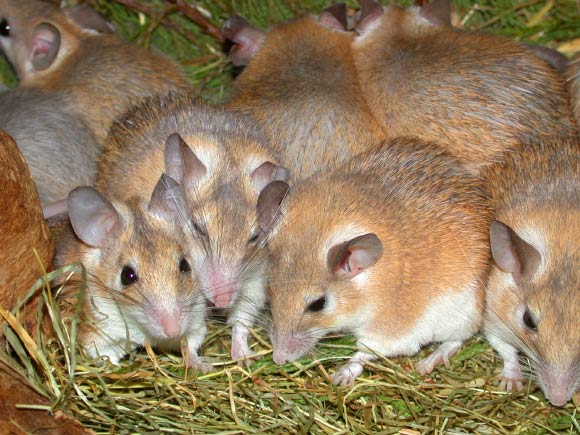Male mice produce highly complex ultrasonic vocalizations (USVs) to seduce females, says a team of biologists led by Duke University Medical Center.

Arabian spiny mice (Acomys cahirinus). Image credit: Andy Mabbett / CC BY-SA 3.0.
For more than a half of century, it has been known that mice emit what’s called USVs.
These sounds are known to occur in the wild when a mouse pup calls for its mother. And USVs grow more complex as mice reach adulthood.
But scientists are still trying to decode the songs and determine how they vary across different social situations.
The team led by Duke University Medical Center scientists Dr Jonathan Chabout and Dr Erich Jarvis developed a new computational approach for analyzing mouse songs.
Informed by their analyses of male songbirds’ courtship songs, the scientists studied the dynamics between the various syllables in a given mouse song, defined as a series of utterances or syllables strung together, sometimes with a tempo.
They found that male mice sing more complex songs when they smell a female’s urine but don’t see her.
By comparison, the songs are longer and simpler when the males sing directly to the female in her presence.
“We think this has something to do with the complex song being like a calling song, and then when he sees the female, he switches to a simpler song in order to save energy to chase and try to court her at the same time,” said Dr Jarvis, who is the senior author of the paper published online in the journal Frontiers of Behavioral Neuroscience.
“It was surprising to me how much change occurs to these songs in different social contexts, when the songs are thought to be innate.”
“It is clear that the mouse’s ability to vocalize is a lot more limited than a songbird’s or human’s, and yet it’s remarkable that we can find these differences in song complexity.”
Within a given song, the male mice produce specific patterns rather than random strings of syllables.
“But what did the female mice think of this?” Most female mice prefer spending time by speakers playing the complex tunes.
“The fact that the females reacted differently to the different songs further strengthens the group’s conclusion that these various calls carry meaning,” Dr Chabout said.
The team plans to investigate the role of various genes and brain areas in the songs.
_____
Jonathan Chabout et al. 2015. Male mice song syntax depends on social contexts and influences female preferences. Front. Behav. Neurosci., 9: 76; doi: 10.3389/fnbeh.2015.00076







